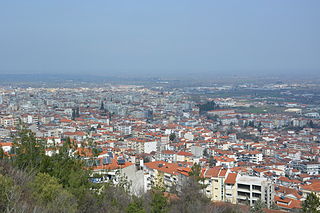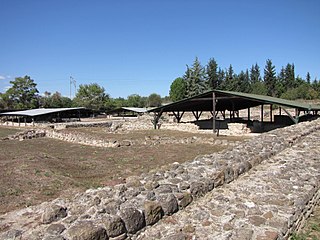This article relies largely or entirely on a single source .(October 2012) |

The Byzantine Museum of Veroia is a museum in Greece that opened in 2002. The museum focuses on artefacts from the Byzantine and Ottoman empires
This article relies largely or entirely on a single source .(October 2012) |

The Byzantine Museum of Veroia is a museum in Greece that opened in 2002. The museum focuses on artefacts from the Byzantine and Ottoman empires
| Established | 2002 |
|---|---|
| Location | Veroia, Central Macedonia, Greece |
| Type | History Museum |
| Key holdings | Veroia, Part of the Byzantine Empire; |
| Website | https://en.discoververia.gr/byzantino-mouseio-verias-2/ |
The museum is housed in the old Markos mill; a rectangular, stone, four-story industrial building with an area of 720 sq.m. that was built between 1908 and 1911 and served as a flour mill until the 1960s. A fire in 1981 burned down much of the building, but due to its historical value it was decided to restore it and turn it into a museum. It was inaugurated in 2002. The building is located in the neighbourhood of the preserved district of Kyriotissa.
The museum contains a collection of Byzantine, Post-Byzantine and Ottoman objects originating mainly from the Veria city area . Among them are mosaics, ceramic vessels, miniatures, burial finds, frescoes, icons, architectural sculptures, manuscripts, wood carvings, marble inscriptions, pottery, coins, tombstones and architectural elements.
The permanent exhibition is organised into several sections:
Coordinates: 40°31′09″N22°12′12″E / 40.5191°N 22.2034°E

Islamic art is a part of Islamic culture and encompasses the visual arts produced since the 7th century CE by people who lived within territories inhabited or ruled by Muslim populations. Referring to characteristic traditions across a wide range of lands, periods, and genres, Islamic art is a concept used first by Western art historians since the late 19th century. Public Islamic art is traditionally non-representational, except for the widespread use of plant forms, usually in varieties of the spiralling arabesque. These are often combined with Islamic calligraphy, geometric patterns in styles that are typically found in a wide variety of media, from small objects in ceramic or metalwork to large decorative schemes in tiling on the outside and inside of large buildings, including mosques. Other forms of Islamic art include Islamic miniature painting, artefacts like Islamic glass or pottery, and textile arts, such as carpets and embroidery.

Vergina is a small town in northern Greece, part of Veria municipality in Imathia, Central Macedonia. Vergina was established in 1922 in the aftermath of the population exchanges after the Treaty of Lausanne and was a separate municipality until 2011, when it was merged with Veroia under the Kallikratis Plan.

Imathia is one of the regional units of Greece. It is part of the region of Central Macedonia, within the geographic region of Macedonia. The capital of Imathia is the city of Veroia.
Byzantine art comprises the body of Christian Greek artistic products of the Eastern Roman (Byzantine) Empire, as well as the nations and states that inherited culturally from the empire. Though the empire itself emerged from the decline of Rome and lasted until the Fall of Constantinople in 1453, the start date of the Byzantine period is rather clearer in art history than in political history, if still imprecise. Many Eastern Orthodox states in Eastern Europe, as well as to some degree the Islamic states of the eastern Mediterranean, preserved many aspects of the empire's culture and art for centuries afterward.

Albanian art refers to all artistic expressions and artworks in Albania or produced by Albanians. The country's art is either work of arts produced by its people and influenced by its culture and traditions. It has preserved its original elements and traditions despite its long and eventful history around the time when Albania was populated to Illyrians and Ancient Greeks and subsequently conquered by Romans, Byzantines, Venetians and Ottomans.

The Church of Saint Demetrius, or Hagios Demetrios, is the main sanctuary dedicated to Saint Demetrius, the patron saint of Thessaloniki, dating from a time when it was the second largest city of the Byzantine Empire. It is part of the site Palaeochristian and Byzantine Monuments of Thessaloniki on the list of World Heritage Sites by UNESCO since 1988.

Macedonian Renaissance is a historiographical term used for the blossoming of Byzantine culture in the 9th–11th centuries, under the eponymous Macedonian dynasty (867–1056), following the upheavals and transformations of the 7th–8th centuries, also known as the "Byzantine Dark Ages". The period is also known as the era of Byzantine encyclopedism, because of the attempts to systematically organize and codify knowledge, exemplified by the works of the scholar-emperor Constantine VII Porphyrogennetos.

Turkish art refers to all works of visual art originating from the geographical area of what is present day Turkey since the arrival of the Turks in the Middle Ages. Turkey also was the home of much significant art produced by earlier cultures, including the Hittites, Ancient Greeks, and Byzantines. Ottoman art is therefore to the dominant element of Turkish art before the 20th century, although the Seljuks and other earlier Turks also contributed. The 16th and 17th centuries are generally recognized as the finest period for art in the Ottoman Empire, much of it associated with the huge Imperial court. In particular the long reign of Suleiman the Magnificent from 1520 to 1566 brought a combination, rare in any ruling dynasty, of political and military success with strong encouragement of the arts.

The Numismatic Museumof Athens is one of the most important museums in Greece and it houses a collection of over 500,000 coins, medals, gems, weights, stamps and related artefacts from 1400BC to modern times. The collection constitutes one of the richest in the world, paralleled by those of the British Museum in London, the Bibliothèque Nationale in Paris, the State Hermitage Museum in St. Petersburg, the Bode Museum in Berlin, and the American Numismatic Society in New York. The museum itself is housed in the mansion of the archaeologist Heinrich Schliemann, formally known as Iliou Melathron.

Veria, officially transliterated Veroia, historically also spelled Berea or Berœa, is a city in Central Macedonia, in the geographic region of Macedonia, northern Greece, capital of the regional unit of Imathia. It is located 511 kilometres north-northwest of the capital Athens and 73 km (45 mi) west-southwest of Thessaloniki.

The Museum of Byzantine Culture is a museum in Thessaloniki, Central Macedonia, Greece, which opened in 1994.

The Archaeological Museum of Dion is a museum in Dion in the Pieria regional unit of Central Macedonia, Greece.

The National Museum of Aleppo is the largest museum in the city of Aleppo, Syria, and was founded in 1931. It is located in the heart of the northern city on Baron Street, adjacent to the famous Baron Hotel and near the Bab al-Faraj Square and Clock Tower. The majority of the museum's exhibitions are devoted to the archaeology of Syria, with most of the finds coming from archaeological sites of the northern part of the country.

Tarsus Museum is an archaeology and ethnography museum in Tarsus, Mersin Province, in southern Turkey.

The Old Metropolis is an early 11th-century Byzantine basilica, dedicated to Saint Paul, that during the Ottoman period of the city became an Ottoman mosque as the Hünkar Mosque, in the northern Greek city of Veria.

Byzantine mosaics are mosaics produced from the 4th to 15th centuries in and under the influence of the Byzantine Empire. Mosaics were some of the most popular and historically significant art forms produced in the empire, and they are still studied extensively by art historians. Although Byzantine mosaics evolved out of earlier Hellenistic and Roman practices and styles, craftspeople within the Byzantine Empire made important technical advances and developed mosaic art into a unique and powerful form of personal and religious expression that exerted significant influence on Islamic art produced in Umayyad and Abbasid Caliphates and the Ottoman Empire. In addition, Byzantine mosaics went on to influence artists in the Norman Kingdom of Sicily, in the Republic of Venice, and, carried by the spread of Orthodox Christianity, in Bulgaria, Serbia, Romania and Russia. In the modern era, artists across the world have drawn inspiration from their focus on simplicity and symbolism, as well as their beauty.

The Worcester Hunt Mosaic is a large Byzantine floor mosaic located at Worcester Art Museum in Worcester, Massachusetts. The mosaic was originally constructed for an upscale villa in Daphne, just outside of Antioch. The mosaic was discovered during an archeological expedition which lasted between 1932 and 1939. It is currently the largest Antioch mosaic located within the United States. It measures approximately 20.5 feet x 23.3 feet.

In the construction of the railway line between Athens and Thessaloniki, a fortified bishop's seat from the Byzantine era was discovered in Louloudies.

Archaeological and historical finds, as well as contemporary works of art are displayed in the museums and exhibitions at Mount Olympus.
The Veria railway station is the railway station of Veria in Central Macedonia, Greece. The station is located near the center of the settlement, on the Thessaloniki–Bitola railway, and is severed by both Local and Proastiakos The station lies some 72 kilometres (45 mi) away from Thessaloniki.